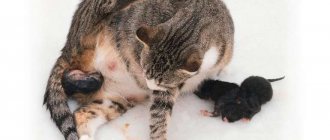The body temperature of cats differs from that of humans, and the normal body temperature of felines ranges from 38 to 39 degrees. Using thermometry methods - rectally or in the ear canal, you can understand that the cat has a temperature.
Unfortunately, there are no other accurate methods. If you notice that your cat's body is suspiciously warm, you should not panic prematurely. Perhaps the pet simply overheated under the sun's rays or overate. The absence of other symptoms, as well as the normalization of temperature after a few hours, does not indicate pathology.
What temperature is considered normal, low, high
Cats, like any living beings, have individual characteristics. Normally, a cat's body temperature ranges from 38 to 39.5 degrees. Naturally, such a large range raises a number of doubts among inexperienced owners, let's take a closer look.
The optimal base body temperature of a cat is considered to be 38.5 degrees. When an animal is sleeping or in a state of complete rest, due to a slowdown in metabolism, the base body temperature can drop to 38 degrees.
In young cats and kittens, the base body temperature is usually higher and ranges from 39 to 39.5 degrees.
Almost all cats have body temperatures that change throughout the day. Typically, lower rates are observed early in the morning, when the cat has just woken up and has not yet had time to eat. By the evening, especially during periods of activity, adult, healthy animals may experience an increase in temperature by 1–1.5 degrees.
Note! There are quite a lot of conventions that affect the pet’s base temperature, so some errors in diagnosing diseases are taken into account in advance.
A definite low temperature is considered to be below 38 degrees. Indicators from 35 to 37 degrees are considered critical and may indicate a lethargic or comatose state of the cat.
A fever is considered a body temperature above 40 degrees, although in fact, for an adult, healthy cat, a temperature of 39.5 degrees would be considered elevated.
Signs of fever
Cat body temperature: what is considered optimal and critical
In case of an infectious disease, severe cutting pain, as well as overheating, the animal’s body temperature increases by several degrees. This is evidenced by:
- lethargy of the pet. If the animal is accustomed to periodically running from one room to another, actively pouncing on tasty treats and coming to its owner to be petted, then the opposite behavior should alert the owner;
- rapid pulse. An adult healthy cat has a pulse in the range of 100-160 beats/min. Moreover, in large individuals this indicator is slightly lower than in their small counterparts, and in females it is slightly higher than in males. In kittens up to 4 months of age, the pulse ranges from 160 to 185 beats/min, and in older cats it can range from 75 to 100 beats/min. If your pet's heart is beating faster, this may be a symptom of hyperthermia, which should be investigated immediately;
- dehydration. It occurs if the cat consumes less fluid than it loses. It is also a sign of many ailments, for example, viral infection, diabetes, indigestion, etc. Lack of fluid in the body can seriously affect the health of the tailed animal and cause irreparable damage to the functioning of internal organs, especially the kidneys. You can tell if a moustached animal is dehydrated by the animal’s dry gums.
Dehydration is one of the symptoms of dangerous diseases
Important! If hyperthermia (over 40 °C) is detected in a cat, you should immediately take it to a veterinary clinic. In this case, in no case should you lower the temperature yourself with the help of medications. To alleviate the condition of your four-legged friend, you need to put something cool under his neck and paws, and constantly monitor his mustachioed fluid intake.
How to determine a cat's temperature
Let’s immediately figure out how to determine a pet’s temperature without error. Traditionally, a mercury thermometer is used to measure baseline temperature, which is inserted into the anus.
To reduce discomfort, before inserting into the anus, the tip of the thermometer must be warmed in your hands and thoroughly lubricated with Vaseline. It is advisable for the cat to lie on its side, although some animals tolerate the procedure easier in a standing position.
As you know, a measurement with a mercury thermometer is considered accurate if it was carried out for 7–10 minutes. Be careful to hold the thermometer firmly as the cat may relax and tense, causing it to move in the rectum.
During the entire period of temperature measurement, the pet must be held firmly, since careless movements and sudden movements can lead to damage to the thermometer and injury.
Note! It is possible to reduce the time required to measure temperature using an electronic thermometer. The measurement method is similar, but its duration is 2–5 minutes. As soon as the measurement is completed, the thermometer gives a signal.
Modern technology offers several methods of measuring temperature with less discomfort for your pet. Clinics often use thermometers that quickly record the temperature using a measurement in the auricle. The device is specific, veterinary and not cheap.
Many owners have adapted to measuring the temperature of their pets using children's, non-contact thermometers.
The operating algorithm of the device is simple: an infrared beam is directed to the area of the body whose temperature needs to be measured. As you know, the difference in temperature between the skin and internal organs can be 2–3 degrees.
Note! The use of non-contact thermometers quite often gives a serious error.
In what cases can the owner provide assistance himself?
For example, a kitten cut its paw on a sharp object. Minor abrasion. And is it really necessary to take him to the doctor? Well, of course, the owner can handle this on his own. It is enough to wash the cut with a 3% hydrogen peroxide solution and then treat it with a chlorhexidine solution. But at the same time, you also need to evaluate whether the cut is deep and observe whether the bleeding has stopped. If the cut is deep and the bleeding does not stop for a long time, then it is still worth showing your pet to a specialist.
What if the owner discovered ringworm on his pet? He can handle this on his own too. Purchase ointment from a veterinary pharmacy and treat the affected area with it. It is important to maintain hygiene for the animal and all family members, since the disease is contagious.
Allergic and infectious diseases of the eyes and nose, and damage to the ears by ear mites can also be treated by purchasing the appropriate drops and ointments from a veterinary pharmacy. But you need to monitor the condition of the cat. If there is no improvement within 3-4 days, then still consult a specialist.
If there are signs of poisoning in a pet, an adsorbent (smecta) and drinking in large quantities is necessary. If the pet refuses water, forced drinking through a syringe is used. And again, if there is no improvement in the condition, a doctor’s examination is required.
How to determine temperature without a thermometer
Determining body temperature without a thermometer is always fraught with error. Note that tactile temperature determination does not provide enough data to suspect a lethargic state or fever in a cat. A critical decrease and increase in temperature are considered equally dangerous conditions.
On the cat's nose
Many owners believe that body temperature is determined by the nose. The cliché says: “a cold and wet nose means there is no temperature, a hot and dry nose means there is a temperature.”
- In fact, a cool, wet nose is normal when your cat is active.
- If your pet has slept in a warm place for a long time, a dry and warm nose will be considered normal.
- During a fever, your cat may have a hot and runny nose, which may indicate the development of a viral or infectious disease.
By the ears
The next reference point by which it is customary to determine temperature is the ears. The diagnostic method cannot be called accurate, but the data obtained by it is clearly closer to the truth than “nasal diagnosis”.
A cat's ears are covered with thin, sensitive skin without a layer of fat. Blood vessels lie directly under the skin, so tactile sensations provide fairly accurate data on body temperature.
Note! It's important to note that your ears may feel much hotter than their actual temperature. Ears may be cold with a fever if the cat is exhausted or dehydrated.
Along the armpits
The armpits and peritoneal area, provided there is no large amount of fur, also serve as indicators for determining temperature.
- To properly feel your body temperature, your hands need to be warm.
- The palms are placed on an open area of the body and held for several seconds.
- If your skin quickly adapts to body temperature, the temperature is most likely normal.
By mucous membranes
Mucous membranes are one of the most accurate landmarks for determining body temperature without a thermometer.
- At elevated temperatures, a cat's gums are hot to the touch, and their pigmentation becomes more intense (pink or even red).
- At low temperatures, the color of the gums fades to whitish, bluish, yellowish or gray (discolored). At the same time, the gums seem cold to the touch.
Maybe the cat is sick?
There are usually several dangerous symptoms indicating an unhealthy state of a pet. And if you notice something suspicious about your pet, then analyze its condition as a whole.
Signs that a cat is sick:
- The animal became inactive. The pet does not react to toys, food, and even irritants that previously caused a strong reaction in him (for example, a vacuum cleaner). Spends most of his time sleeping.
- The animal, on the contrary, can become very active. For example, if your cat follows you and constantly meows for no reason, he may be trying to show you that something is bothering him.
- Refuses food completely or partially. Loss of appetite is observed in cats during the hot season. This is due to the fact that many breeds have difficulty withstanding heat. But by autumn, appetite is usually restored. If the loss of appetite is not associated with temperature changes, and is also accompanied by apathy of the pet, then most likely he is sick.
- Painful urination. The pet's urine becomes dark in color and when visiting the litter box, the cat may meow in pain. All of the above symptoms may indicate urolithiasis.
- Watery or purulent discharge from the nose or eyes can be a sign of both allergic reactions and infectious diseases.
- Scratching the ears and the area nearby, neck. In this case, it is worth checking your pet for the presence of ear mites, fleas and other ectoparasites.
- Diarrhea, nausea, vomiting. May be a sign of animal poisoning.
- The animal does not step on its paw. This may be a sign of either a dislocation or sprain, or external damage (cut, abrasion).
- Hair loss and the formation of bald patches are often a sign of ringworm. The disease is contagious.
- Bloating in general or enlargement/bulging of a particular area. More often it is a sign of liver disease or other internal organs.
- Presence of blood, pus, and mucus in feces.
- Increased body temperature.
- Loss of body weight.
- Putrid odor from the mouth or ear.
Signs of a fever in a cat
Since the mucous membranes have the temperature closest to the true value, during fever the following is observed :
- Unhealthy shine in the eyes.
- Constant licking of the muzzle.
- Hot breath.
- Redness of the eyelids and mucous membranes of the anus.
- Breathing becomes fast and intermittent.
- Chills and, as a result, tremors.
At low body temperature the following is observed:
- Decreased breathing rate.
- Lack of normal eye brightness and blinking frequency.
- Slow reaction of the pupil to light.
- The gums and nose may appear tight.
- Saliva becomes thick.
- Tremor in the initial stages, as a means to increase blood circulation.
Behavioral signs also indicate fever or lethargy. First of all, the owner will notice a bright contrast in the pet’s activity. A playful, cheerful cat, she can lie for hours, ignore her name and stop licking herself. Without proper care, the coat quickly loses its healthy shine.
Note! Poor health is accompanied by drowsiness. However, this symptom is difficult to detect because healthy cats can sleep up to 16–18 hours a day.
Lack of appetite is always an alarming sign, with the exception of a natural hunger strike, which cats usually go on in the spring. If your cat refuses to eat, but remains active and cheerful, there is nothing to worry about. If you notice that the cat wants to eat, but cannot or has completely lost its appetite, you need to be wary, and it is better to immediately consult a doctor.
A fever may be indicated by sudden onset of diarrhea or vomiting. Disturbances occur due to the death of intestinal microflora, which is not resistant to an increase in basic body temperature. During lethargy, metabolic processes slow down, as a result of which the animal goes to the toilet less often.
What's wrong with the cat?
A loving owner, of course, knows perfectly well all the habits and manners of his pet. And he will easily notice any deviation from the norm. But we must not forget that as an animal grows up, it becomes calmer, and its life becomes more measured. And just recently, a playful baby, carefree chasing balls and toys on the floor, may begin to spend more time in a bed or on the window and sleep more than play. It is important to correctly assess the situation here. Is this behavior a sign of illness or is something bothering the pet, or is it just growing up and a certain stage in the cat’s life.
What to do if your cat has a fever
If your cat has a fever for unobvious reasons, you should contact your veterinarian. If you cannot see a doctor, it is advisable not to use medications.
You can help your cat's body cope with fever in several ways:
- Move your pet to a ventilated room and keep it calm.
- Give your cat vitamin B (you can drink it from an ampoule, after mixing it with warm water).
- Spray the wool with water until it is slightly damp.
- Provide your pet with clean, cool water.
- Without a doctor's prescription, you can use immunostimulants, for example, Catozal or Gamavit.
If your pet's temperature rises above 40 degrees, you can't wait! Consult your veterinarian by phone.
Typically, during remote treatment, doctors prescribe:
- Amoxicillin is a broad-spectrum antibiotic.
- Meloxicam is a strong broad-spectrum anti-inflammatory drug.
- Immunostimulants.
Important! To eliminate a fever in a cat, paracetamol and ibuprofen should absolutely not be used. Under the supervision of a doctor, aspirin (very rarely), analgin and diphenhydramine (injection or suppositories) are used.
Signs of low temperature
Hypothermia (37.4 °C and below) may indicate a general weakening of the body, the presence of an infectious or viral infection, or a worsening of the underlying disease. After hypothermia or undergoing surgery using anesthesia, the development of hypothermia is also possible. So, how can you tell if your cat has a low temperature? The most common signs include:
- shiver. The main physiological mechanism that is primarily triggered by hypothermia is involuntary muscle contraction (severe and uncontrollable trembling);
- shelter in a warm place. If your cat is looking for a warm place in the house and his body is shaking a little, he most likely has hypothermia.
The cat has a fever: what to do at home
In order for your pet's thermal state to normalize, you need to wrap it in a warm blanket, then place it near a radiator or use a heating pad.
Important! If the decrease in temperature did not occur as a result of the surgery, and also if the pet does not warm up for a long time or loses its appetite, it is necessary to immediately consult a veterinarian.
First aid at home before the doctor arrives
Until the doctor comes, you can alleviate your pet’s condition using the following measures:
- Calm and caress the cat, give it a light massage.
- Provide access to clean, fresh water. High temperature is a cause of dehydration. If your pet refuses to drink, force it to drink. A kitten's temperature can cause weakness, in which it will not be able to drink on its own - feed it with a syringe without a needle, often in small portions.
- Wrap the cat in a towel soaked in cold water and wrung out thoroughly.
- Apply ice wrapped in a towel to your inner thighs.
- Wrap your paws in gauze soaked in vodka.
- Place the pet's bed in a cooler place. Ventilate the room in which the animal is located.
Only after examining the animal can you give medications as prescribed by the doctor.
Change in temperature after sterilization surgery
For the first three days after surgery, it is necessary to monitor the temperature and condition of the animal.
Sterilization of a cat or castration of a cat is impossible without surgery and putting the animal under anesthesia, as with any other operation.
After the animal awakens from anesthesia, in the first three days it is necessary to care for and monitor its behavior. The pet's body is weak after surgery and anesthesia. Body temperature is reduced. The deviation on the first day can occur by 1-2ﹾC. An elevated temperature may occur over the next three days. If it continues to increase in subsequent days, this may indicate an inflammatory process as a result of infection, or a complication of subsequent surgery. You need to contact a veterinarian.
Things are better for a cat after castration, since the operation is less complicated and dangerous, unlike sterilization of a cat. But even here, an elevated temperature may be observed in the first three days after castration and this is a normal reaction to the operation. However, if this continues, the animal may have started an inflammatory process.
If your pets have a low temperature after surgery, it is necessary to provide them with warmth.
It is important to measure the animal's temperature in the first three to four days of postoperative procedures and anesthesia. If at the end of the three-day period the temperature has returned to normal, the animal’s mood has improved, and the animal’s appetite has increased, it means that the operation was successful and there is nothing to worry about.
First aid kit for cats
If you have a cat at home, it is better to prepare a first aid kit in advance for unforeseen situations. A first aid kit may include the following:
- Hydrogen peroxide solution 3%;
- Chlorhexidine bigluconate solution;
- Antihistamine;
- Antibiotic eye drops;
- An anthelmintic, such as Milbemax;
- Smecta;
- Bandage;
- Cotton wool;
- Bactericidal patch.
Adviсe
To avoid many health problems in your cat, it is advisable to follow some rules:
- Balanced cat nutrition;
- Give vitamin complexes regularly (2 times a year);
- Regular vaccination and deworming;
- Avoid contact with sick animals;
- Walks in the open air,
- Hygiene of ears, eyes and fur.







![Temperature in cats [normal, elevated, decreased]](https://zooservice-osetia.ru/wp-content/uploads/temperatura-u-koshek-normalnaya-povyshennaya-ponizhennaya-330x140.jpg)



